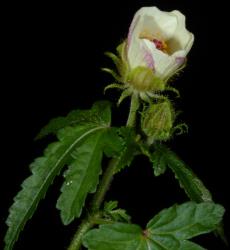- Taxon
- Gallery
- = Hibiscus trionoides G.Don, Gen. Hist. 1, 483 (1831)
Herb 0.2–1.0 m tall. Branchlet with fine stellate hairs 0.2–0.8 mm long and coarser stellate hairs 0.4–0.7 mm long, with sparse coarse bristles 0.3–0.6 mm long, and with sparse fine bristles 0.2–0.5 mm long. Stipules more or less persistent, 4–5 mm long. Mid-stem and distal leaves 3-lobed (rarely unlobed, or 5- or 7-lobed), lobing not extended to the apex of the petiole, the primary lobes themselves scarcely lobed, palmately veined; lamina of mid-stem leaves 20–65 mm long, 15–45 mm wide, in overall shape ovate, or broadly ovate, with fine and coarse stellate hairs, margin strongly serrate, lobe apex acute or obtuse; petiole 10–30 mm long with indumentum similar to that of the branchlet; foliar nectary absent. Flowers solitary in leaf axils, chasmogamous, pedunculate; peduncle 10–20 mm long, with fine and coarse stellate hairs, rarely also with fine bristles; pedicel 4–10 mm long, indumentum dissimilar to that of peduncle (stellate hairs longer and denser, coarse bristles present). Epicalyx 12–14-segmented, 10–13.5 mm long, segments linear, free at the base, shorter than the calyx to equally as long as the calyx. Calyx at anthesis 13–15 mm long, distinctly accrescent in fruit, with stellate hairs, fine and coarse bristles and sparse glandular hairs, without prominent marginal ribs; lobes triangular, acute at the apex; calyx nectary absent. Petal 19–26 mm long, yellow distally faintly flushed pink, base sometimes with fine pale red striations. Staminal column 7–10 mm long with the stamens distributed along the distal 4–7 mm of the column; staminal filaments 1–2.3 mm long; anthers yellow; pollen yellow. Style (including style branches) exserted 2.3–3.8 mm beyond the apex of the staminal column; style branches 5, 2.3–3 mm long; stigmas capitate, 0.8–1.2 mm across, stigmatic hairs 0.1–0.2 mm long. Ovary hairy. Fruit, capsulate. Capsule hairy, 10–12 mm long. Seed 2–2.2 mm long, subreniform, papillate-pubescent and smooth between the hair pustules.
[Reproduced from Craven et al. (2011, New Zealand J. Bot. 49: 27–40) with permission from The Royal Society of New Zealand.]




